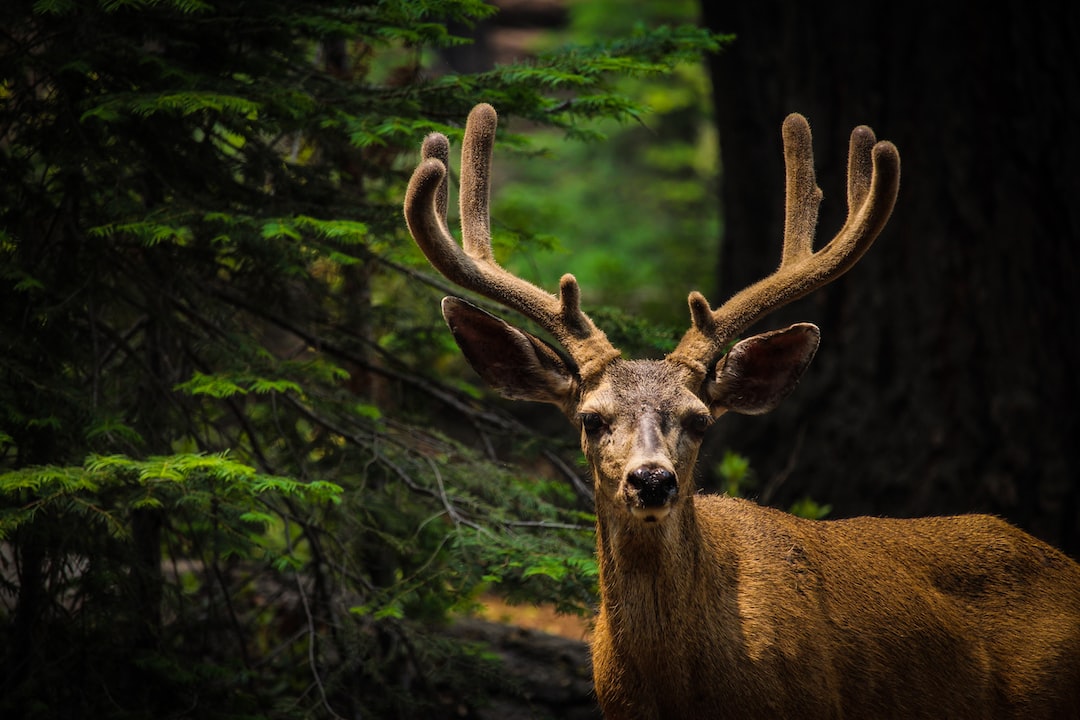Are you an avid hunter looking to learn more about the difference between typical and non-typical deer?
Do you know how to score a buck based on its antler configuration? Are whitetail and mule deer two distinct species or variations of each other?
We’ll cover all this and more in our post as we discuss typical vs non-typical deer.
From learning how to identify the various types, scoring systems for both kinds, as well as their unique characteristics – we’ve got it in here.
So let’s dive into some hunting knowledge that will help us better understand these majestic creatures.
What is the Difference Between Typical and Non-Typical Deer?
Typical and non-typical deer are two distinct categories of deer that can be found in the wild. The difference between them lies primarily in their antlers, which vary significantly in size, shape, and complexity.
Check this video out for an easy breakdown on the difference:
Definition of Typical and Non-Typical Deer:
A typical deer is one whose antlers have a symmetrical set of points on each side with an even number of tines or points per side. These tines typically grow from the main beam at equal distances apart.
A non-typical deer has antlers that do not follow this pattern; they may have extra points or unevenly spaced tines on one side or both sides.
Physical Characteristics of Typical and Non-Typical Deer: Typically, a typical buck will have larger body mass than its non-typical counterpart due to its more balanced frame caused by having evenly distributed weight throughout its body structure.
The differences between typical and non-typical deer are minimal but distinct, ranging from physical characteristics to scoring criteria.
Now that we have discussed the difference between them, let’s look at how to score a typical buck.
How to Score a Typical Buck
Scoring a typical buck is an important part of the hunting process, and can be done with some simple steps. To begin, you will need to identify points on the buck’s antlers.
Typical bucks have two main antler points that are scored: inside spread and outside spread. Inside spread is measured from the base of one antler to the base of its opposite counterpart, while outside spread measures from tip-to-tip across both antlers.
You should also look for any abnormal points or additional brow tines which may add extra score to your total tally.
Once all points have been identified, it’s time to calculate your total score for a typical buck. This is done by adding up all individual measurements (inside and outside spreads) plus any additional abnormal point scores you may have found earlier in your inspection process.
It’s important to note that there are different scoring systems used throughout North America; make sure you know which system applies in your area before calculating your final score.
The last step in scoring a typical buck is determining its age based on its physical characteristics such as body size, coat coloration, and teeth wear patterns. This can help provide an estimate as to how old the animal was when harvested.
A mature deer typically has larger body mass than younger animals; darker colored coats; and more worn down teeth due to their age-related wear and tear over time compared with younger animals who still possess white tooth enamel surfaces on their molars or premolars.
Additionally, if available, examining jawbone samples taken during processing can give even more accurate estimates about age range since they contain information about tooth eruption times specific to each species of deer hunted in North America today.
Now that you understand how to score a typical buck, let’s take a look at the more complex task of scoring a non-typical buck. With its intricate antler formations and extra points, this requires an even greater level of skill and knowledge in order to accurately determine its total score.
How to Score a Non-Typical Buck
Scoring a non-typical buck is not as straightforward as scoring a typical buck. It requires more knowledge and experience to accurately score a non-typical deer. To begin, you must first identify the points on the antlers of the deer.
Non-typical bucks have abnormal points that are usually longer than normal, with extra tines or points growing off of them in unexpected directions. These can be difficult to spot, so it’s important to look closely at each point before counting it towards your total score.
Once all of the points have been identified, you can calculate the total score for the buck by adding up all of its individual measurements and subtracting any deductions due to broken or missing tines or beams.
The official scoring system used by most organizations is called “the Boone & Crockett System” which assigns different scores based on various factors such as length, width, circumference and symmetry between both sides of antlers (if applicable).
The last step in scoring a non-typical buck is determining its age. This can be done by examining its teeth for wear patterns or looking at body size if possible; however, this method is less accurate than using tooth analysis since body size varies from one animal to another depending on diet and other environmental factors. Deer tracks are another way to determine age – older heavier bucks will leave a deeper track in mud and snow.
If you don’t feel comfortable estimating age yourself then consider having an experienced hunter help you out with this task instead.
By understanding the physical characteristics, habitat preferences and hunting strategies of white tail vs mule deer, hunters can be better equipped to identify and score a non-typical buck with accuracy.
Whitetail Vs. Mule Deer
Whitetail vs Mule Deer is a common comparison among hunters in the rural western United States. Both species of deer have their own unique physical characteristics, habitat preferences, and hunting strategies that should be taken into consideration when deciding which type of deer to hunt.
Physical Characteristics of White Tail vs Mule Deer: The most obvious difference between white tail and mule deer is size; white tails are typically smaller than mule deer with an average weight range from 90-300 pounds for adult males compared to 120-400 pounds for adult male mule deer.
Additionally, whitetail antlers tend to grow more quickly than those on mule deer, allowing them to reach larger sizes in less time.
Furthermore, the coloring of both species can vary significantly depending on region and season; however, generally speaking white tails will have reddish brown coats during summer months while mules will remain gray year round.
Habitat Preferences of Whitetail vs Mule Deer:
When it comes to habitat preference there are some distinct differences between these two species as well.
Whitetails prefer wooded areas with thick underbrush while mules prefer open grasslands or sagebrush flats where they can easily spot predators coming from any direction. This means that if you’re looking for a particular type of animal you need to know what kind of terrain they prefer before heading out into the field.
Whitetail and Mule Deer are two of the most commonly hunted species in the western United States, but they differ significantly in terms of physical characteristics, habitat preferences, and hunting strategies. As such, it is important to understand these differences when pursuing either species.
However, non-typical variations can also be found among common species which require different identification techniques and scoring criteria for successful hunts; this will be discussed further in the next heading.
Non-Typical Variations of Common Species
Non-typical variations of common species can be a challenge to identify and score. They are often the most sought after trophies for hunters, as they offer an opportunity to harvest something truly unique.
Identifying Points on Non-Typical Variations:
When identifying points on non-typical variations, it is important to look at the antlers from all angles. Look for any abnormal points or tines that may not appear in typical specimens of the same species.
It is also important to note any asymmetry between each side of the rack and take into account how this affects scoring potential.
Scoring Differences Between Common Species:
The scoring system used for non-typical variations will vary depending on which type of animal you are hunting.
For example, whitetail deer have different criteria than mule deer when it comes to scoring non-typicals due to their differing antler structures and characteristics. Whitetails typically have more “abnormal” points than mule deer, so these should be taken into consideration when assessing a trophy buck’s score potential.
Scouting ahead of time is key as it allows you to locate areas with high concentrations of game animals such as food sources or bedding areas before heading out in search of your trophy buck or bull elk with abnormally shaped racks.
Additionally, using decoys or calling techniques during peak rut periods can help draw in curious bucks looking for a fight.
FAQs in Relation to Typical vs Non Typical Deer
What classifies a deer as non-typical?
A non-typical deer is classified by its antlers, which are considered to be abnormal in shape and size. The main criteria for determining a non-typical deer is that the antlers have more than four points on one side or an irregular pattern of points.
Additionally, the total number of points must exceed what would normally be expected from a typical buck. These unusual characteristics make it difficult to accurately score the animal according to Boone & Crockett scoring standards, making them highly sought after by hunters looking for unique trophies.
What is the difference between a typical and non-typical deer?
A typical deer is characterized by its symmetrical antlers, with each side of the rack mirroring the other. Non-typical deer have antlers that are asymmetrical and may include extra points or an unusual shape. This can be caused by genetics, injury, or even age.
The most common difference between a typical and non-typical deer is the number of points on their antlers; typically a buck will have eight points on its rack while a non-typical might have more than eight points with “cheaters” or “trash” sticking out on the sides.
However, it’s important to note that there are no hard rules when it comes to what makes a buck “non-typical” as some bucks may only have one extra point while others could have several additional ones.
Bottom line is; if it ain’t typical, it’s probably a non-typical.
What is the difference between a typical and non-typical deer rack?
A typical deer rack is the antlers of a deer that grow in symmetrical, matching points. These points are usually evenly spaced and have similar shapes on each side.
A non-typical deer rack is one with at least one point growing outside the normal symmetry or shape of the other points. This can include extra tines, abnormal growth patterns, or even missing tines.
Non-typicals often display more unique characteristics than typical racks and are highly sought after by hunters due to their rarity and value.
What does typical mean in deer?
Typically, deer are ungulates (hoofed mammals) that inhabit a variety of habitats across the world. They have a wide range of sizes and colors depending on their species and geographic location.
Deer are herbivores, meaning they feed primarily on vegetation such as grasses, leaves, fruits, nuts and bark, much like elk. In general, they tend to be solitary animals but can form small herds during certain times of the year when food is plentiful or when seeking safety in numbers from predators.
During mating season males will compete for females with antlers used as weapons to fight off rivals. Deer are also known for their unique ability to detect danger and can run at speeds of up to 30 mph in order to escape predators.
Conclusion
In conclusion, it is important to understand the differences between typical and non-typical deer when hunting.
Typical bucks have antlers that are symmetrical in shape while non-typical bucks may have points or extra growths on their antlers. Knowing how to score a typical buck or a non-typical buck can help you determine which type of deer you should be targeting for your hunt.



